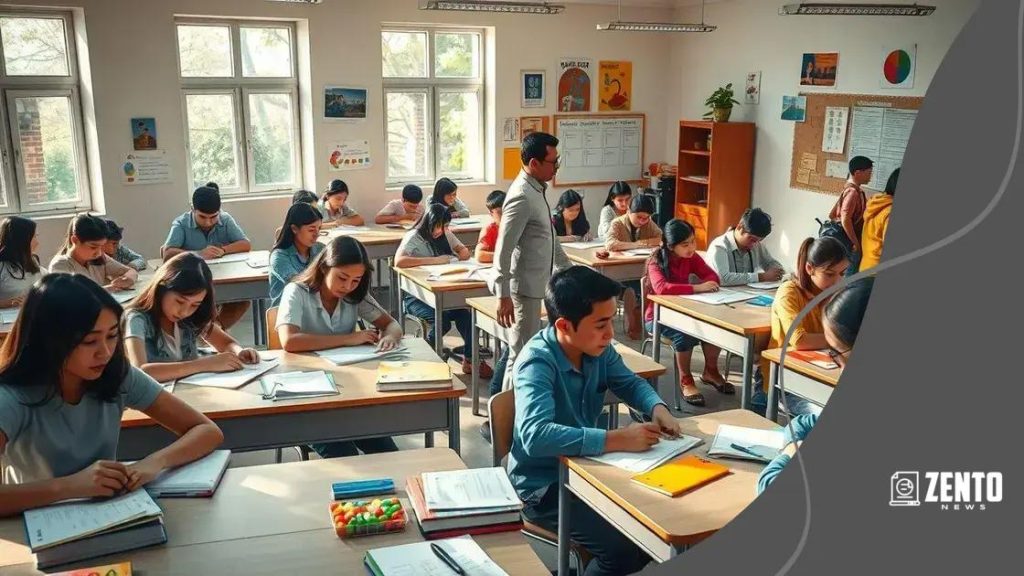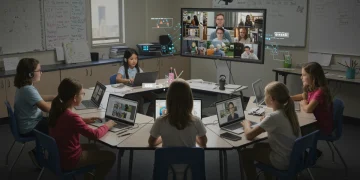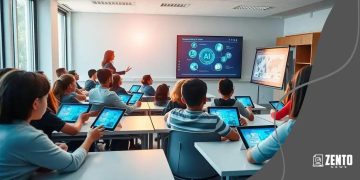Haptic technology for special education: enhancing learning

Anúncios
Haptic technology for special education enhances tactile learning experiences by providing interactive, hands-on tools that engage students and support diverse learning needs.
Haptic technology for special education is transforming how we approach tactile learning. Have you ever considered how touch can enhance education for students with disabilities? This article dives into how this innovative technology is making a difference.
Anúncios
Understanding haptic technology in education
Understanding haptic technology in education begins with recognizing its power to engage learners through the sense of touch. This technology opens up new avenues for students, especially those with special needs, allowing them to connect with lessons in a tactile way.
How Haptic Technology Works
At its core, haptic technology creates sensory feedback through vibrations or motions. This feedback helps learners feel what they are studying. For instance, when learning about shapes, a student can actually feel a model of a triangle or a cube in their hands. This type of learning reinforces concepts in a way that visual aids alone often cannot.
Benefits of Haptic Learning
Incorporating haptic devices in classrooms can lead to numerous benefits:
Anúncios
- Improved Engagement: Students are more likely to participate actively when they can feel what they are learning.
- Enhanced Retention: Tactile experiences can help solidify memory, making it easier to recall information later.
- Inclusivity: Haptic technology caters to diverse learning styles, particularly benefiting students with visual or auditory impairments.
As educators embrace this innovative technology, they create opportunities for all students to learn better. Haptic feedback can transform standard lessons into interactive experiences that foster deeper understanding and enjoyment.
Haptic tools can also facilitate collaboration among students. For example, using devices that allow multiple users to interact with the same tactile elements encourages teamwork and communication. This is particularly beneficial in group activities, where students can share their experiences and help each other learn.
Benefits of haptic feedback for special needs
Understanding the benefits of haptic feedback for special needs students is crucial in enhancing their learning experiences. Haptic technology allows students to interact with educational materials through touch, making learning more engaging and effective.
Engagement and Interaction
One of the key advantages of haptic feedback is that it increases engagement. When students can feel the textures or movements associated with their lessons, they are more likely to participate actively. For instance, when studying geography, a student might grasp a model that represents different terrains, providing a hands-on approach that keeps them interested.
Improved Learning Retention
Another significant benefit is that haptic feedback can lead to improved retention of information. Tactile experiences make learning memorable. Students often remember what they feel much better than what they only see or hear. This experiential learning enhances their understanding of concepts.
- Memory enhancement: Touching and interacting helps solidify learning.
- Versatile applications: Haptic technology can be used across various subjects and skills.
- Personalized learning: Tailored haptic tools can address individual learning styles.
Additionally, haptic feedback promotes emotional and social development. Many students with special needs may struggle with social cues, but engaging with haptic devices in group settings fosters collaboration. As students work together to manipulate tactile materials, they build teamwork and communication skills.
This technology also improves accessibility. For students with visual impairments, haptic feedback provides an alternative means to access information. By relying on touch, these learners can engage fully with their education, bridging gaps that traditional methods may leave.
Incorporating haptic devices in the classroom

Incorporating haptic devices in the classroom is an exciting step towards modern education. These devices allow students to learn through the sense of touch, making lessons more interactive and engaging. Teachers can enhance learning experiences by integrating haptic technology into various subjects.
Types of Haptic Devices
There are several types of haptic devices that can be effectively used in education. Some of these include:
- Wearable Haptic Feedback Devices: These devices can be worn on the body, allowing students to receive tactile feedback while performing tasks.
- Touchscreen Tablets: Tablets equipped with haptic technology provide feedback for touch inputs, making digital learning more tactile and interactive.
- Robotic Kits: These kits let students build and program robots while receiving feedback through touch, combining engineering with a hands-on approach.
Using these devices not only aids in comprehension but also makes learning fun. For example, in a science class, students can use a haptic touchscreen to explore the human body. They can feel the organs as they learn about their functions, deepening their understanding and retention.
Strategies for Effective Incorporation
To successfully incorporate haptic devices into lessons, teachers should consider the following strategies:
- Start Small: Introduce one or two devices to gauge student interest and effectiveness.
- Align with Curriculum: Ensure that haptic learning activities relate directly to the subjects being taught.
- Provide Training: Offer training for teachers and students to maximize the benefits of using these technologies.
As educators become more familiar with haptic devices, they can create innovative lesson plans that cater to diverse learning styles. For instance, a history lesson could involve students feeling artifacts or models from different time periods, driving engagement and making history come alive.
Moreover, involving parents in this transition can enhance support for haptic learning at home. Parents can integrate similar technologies into at-home learning experiences, reinforcing the lessons their children learn at school. This collaboration strengthens the educational journey.
Real-world examples of haptic learning tools
Real-world examples of haptic learning tools demonstrate their effectiveness in educational settings. These tools provide a hands-on learning experience that can significantly enhance student engagement and understanding.
1. Haptic Feedback Robots
One popular example is the use of haptic feedback robots. Students can program these robots to navigate through obstacles while receiving feedback through vibrations or movement. This type of learning allows students to explore coding and robotics in a tangible way, making abstract concepts much clearer.
2. Tactile Tablets
Tactile tablets are another great example. These devices offer touch and feel capabilities, allowing students to interact with graphics and simulations. For instance, when learning about the solar system, students can touch different planets and feel their textures, enhancing retention through interactive learning.
3. Haptic Gloves
Haptic gloves are also revolutionizing how students learn. By wearing these gloves, students can interact with virtual environments. In a biology class, students might use haptic gloves to feel the textures of different tissues, making the learning experience immersive and memorable.
4. Educational Simulators
Educational simulators that use haptic feedback provide practical experiences, like simulating surgeries or mechanical repairs. In medical training, haptic simulators allow learners to practice surgical techniques safely. As they operate the simulator, they receive sensory feedback, replicating real-life situations.
Using these haptic devices in classrooms offers numerous benefits. They foster collaboration among students, as many tools encourage group activities. By working together on haptic tasks, students develop teamwork and communication skills. Furthermore, these devices cater to various learning styles, ensuring that every student can gain from the lessons.
Beyond improving engagement and understanding, haptic learning tools also create a more inclusive classroom environment. Students with disabilities who may struggle with traditional learning methods often find success using these innovative technologies. The tactile nature of haptic tools supports their learning in ways that visuals and auditory methods cannot.
Future trends in haptic technology for education
Future trends in haptic technology for education are exciting and hold great promise for enhancing learning. As technology evolves, educators are finding innovative ways to integrate haptic devices into their classrooms.
1. Enhanced Interactivity
One key trend is the increase in interactivity. Future haptic devices will likely provide even more realistic feedback, making learning experiences immersive. Imagine students feeling the surface of a planet in a science lesson or the texture of a historical artifact in social studies. This level of interaction can make lessons more engaging and memorable.
2. Virtual and Augmented Reality Integration
The integration of virtual reality (VR) and augmented reality (AR) with haptic technology is another major trend. By combining these technologies, students will not just see and hear their lessons but will also physically interact with virtual objects. This will create deeper learning experiences that appeal to different learning styles.
3. Affordable and Accessible Solutions
As technology advances, haptic devices are becoming more affordable. This means that more schools can invest in these tools, making education more inclusive. Additionally, companies are focusing on creating devices that are user-friendly for students with disabilities, ensuring that everyone benefits from haptic learning tools.
4. Data-Driven Personalization
Another trend is the use of data to personalize learning. Haptic devices will gather data on student interactions and performance. Teachers can use this information to tailor lessons to meet each student’s needs. For instance, if a student struggles with a particular concept, the device could offer additional tactile learning opportunities related to that topic.
Moreover, educators will increasingly rely on analytics to understand how haptic feedback affects learning outcomes. This data will help in refining teaching methods and improving student engagement rates.
As these trends develop, haptic technology will continue to redefine the educational landscape. The potential for experiential, hands-on learning is vast and can lead to a generation of students who are better prepared for real-world challenges.
FAQ – Frequently Asked Questions about Haptic Technology in Education
What is haptic technology?
Haptic technology refers to devices that provide tactile feedback to users, allowing them to feel sensations such as textures, shapes, and movements.
How does haptic technology benefit students with special needs?
Haptic technology enhances learning for special needs students by providing tactile experiences that make lessons more engaging and accessible.
What are some examples of haptic learning tools?
Examples include haptic feedback robots, tactile tablets, haptic gloves, and educational simulators that use touch for interactive learning.
What future trends can we expect in haptic technology for education?
Future trends include increased interactivity, integration with virtual and augmented reality, more affordable devices, and the use of data to personalize learning experiences.





